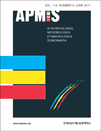Latent tuberculosis infection among new recruits to the army in Beijing, China in 2009
Abstract
Wu X, Liang Y, Wang L, Wang Z, Zhang C, Yang Y, Zhang J. Latent tuberculosis infection among new recruits to the army in Beijing, China in 2009. APMIS 2011; 119: 377–84.
China is a country with high latent tuberculosis infection (LTI) and has a policy of routine BCG vaccination. To monitor tuberculosis (TB) infection, a total of 907 new recruits to the army were interviewed and routinely examined by chest radiographs. They were intradermally injected with purified protein derivative (PPD) and detected with enzyme-linked immunospot (ELISPOT) assay with recombinant CFP-10/ESAT-6 (rCFP-10/ESAT-6) fusion protein, as a stimulus, from December 2009 to February 2010. The prevalence of LTI among new recruits was estimated as 50.2% and 30.7% by PPD skin test and ELISPOT assay, respectively. Of 452 PPD-negative and 455 PPD-positive volunteers, 132 (29.2%) and 146 (32.1%) were ELISPOT positive, respectively. The overall consistency between these two tests was 51.4% (466/907). Although 65.6% of PPD-positive volunteers and 27.8% of ELISPOT-positive volunteers (spot-forming cells; SFC 12.2 ± 21.2) could find the vaccination scars on their arms, 21.3% of PPD-positive volunteers and 35.9% of ELISPOT-positive volunteers (SFC 18.3 ± 34.6) could not. Thus, the TB infection rate in army recruits in China was not as high as previously reported. The results suggest that the ELISPOT technique, we presented, is an accurate method for screening TB infection in China.




